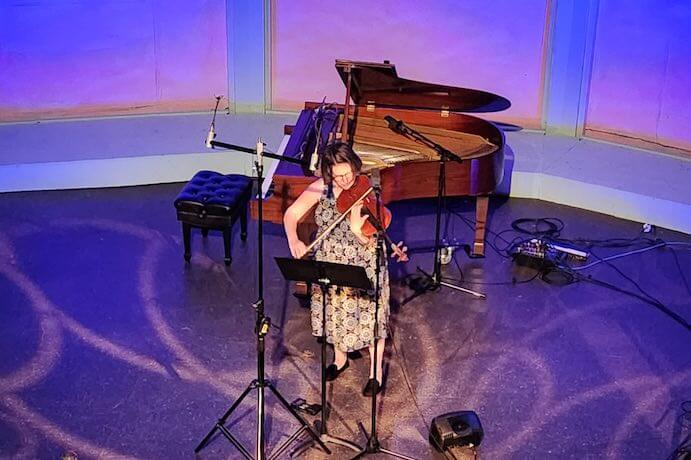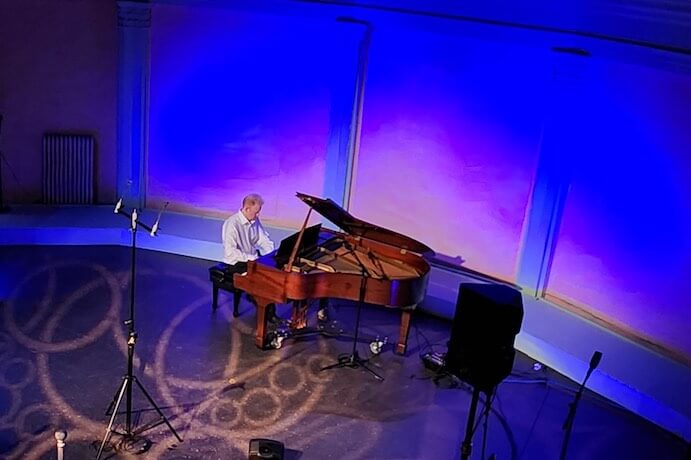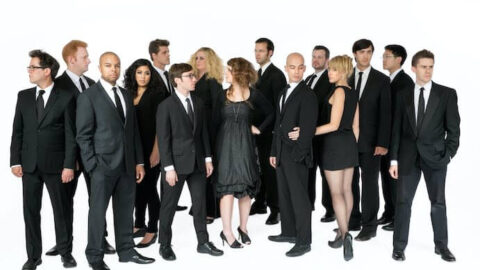New York’s Talea Ensemble held its 15th anniversary concert – a set of four solo pieces – on May 30 at the West End Theatre, a 72-seat space with a domed ceiling on the second floor of an Upper West Side church. It might seem like an unusual choice to celebrate an ensemble’s anniversary with a concert of solo works; solos are notoriously difficult to compose and perform, and are very different from chamber and sinfonietta music. But the concert was the third in a series called Talea Encores, in which members of the ensemble re-present solos from their established repertoire in order to build community between Talea members and composers whose work they champion.
Violist Hannah Levinson opened the concert with Tombstone (2007) by the US-based Iranian composer Bahar Royaee. The piece explores a variety of Saariaho-esque string techniques, including circular bowing, extreme sul tasto and sul ponticello playing, quiet harmonics, tremolo at the bow tip, and alternating bow pressure and speed to elicit textures of unspecified pitch. Levinson drew moments of beauty out from the sonic submersion of interference and scratch tones, and the 14-minute work ended just as we began to hear a yearning voice from beneath the surface.

Originally commissioned by Radio France and IRCAM in 2007-2008, Georges Aperghis’ Dans le Mur was written as part of an older programme at IRCAM where composers were not required to be fluent in programming or other forms of electronic music production. The 15-minute piece for piano and electronics was composed with the technical support of Sébastien Roux, and later, Mike Solomon.
Once a technical hiccough was resolved, pianist Steven Beck performed the challenging work prodigiously; it requires stamina, agility, and intense focus in the exploration of registral extremes and a percussive playing style. The electronic part consisted of unrelenting digital delay lines and time-stretched piano harmonics, which frequently overwhelmed the sound from the live piano. There was a stunning glimmer towards the final part of the piece; a hard cut in the wall of electronic sound revealed live piano and LFO-processed electronics, but the piano was quickly subsumed again. The energy levels of the piano and the electronics occasionally matched each other, but Dans le Mur almost always calls for one body to engulf the other.

Next, Mike Lormand performed the US premiere of Who are you not to be?, a piece for solo trombone by South African composer Andile Khumalo. Written in 2017, the work explores extended trombone techniques, especially the use of a harmon mute with its stem in, offering a study of the timbral contrasts possible within a very specific sound. In the later part of the piece, Lormand produced glorious pedal tones and a plaintive chorale punctuated by perfectly pitched vocal multiphonics.
My favourite piece of the evening was Geli Li’s The Embrace of the Wind for solo cello and electronics, performed by Christopher Gross. Li’s composition requires precise control of time, density, and intensity. Spidery, skittery, high-pitched tremolos are perfectly integrated with spatialised electronics that extend the live performance. The electronics are sometimes present and sometimes absent; when present, they are a perfect counterweight to the live instrument’s timbral explorations. The extended techniques here – playing on the tailpiece, ricochet bowing, pizzicato glissandi, and air tones – create a spare soundscape in which there is space for the electronics to creep in malignantly, broadening the expanse of the solo cello into a damp, dark, cavernous underground.
So often, exceptional pieces are performed once and then forgotten or laid aside. Part of the difficulty is that it’s not often that formidable chamber musicians have time to work on and present solo works as part of an ensemble’s season. Talea’s programme showed consistency in style and matched two unaccompanied solos with two works enhanced with electronics, and introduced the audience to work by four composers interested in the texture of sound and the hidden layers underneath.
I CARE IF YOU LISTEN is an editorially-independent program of the American Composers Forum, and is made possible thanks to generous donor and institutional support. Opinions expressed are solely those of the author and may not represent the views of ICIYL or ACF.
You can support the work of ICIYL with a tax-deductible gift to ACF. For more on ACF, visit the “At ACF” section or composersforum.org.
























